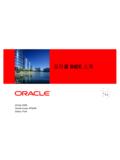Transcription of UI BUILDERTM FOR ACCESS ENTERPRISE EDITION …
1 UI BUILDERTM FOR ACCESS ENTERPRISE EDITION VERSION 5 application guide Version 1/13/18 This document is copyright 2007-2018 OpenGate Software. The information contained in this document is subject to change without notice. If you find any problems in the documentation, please report them to us in writing. This document is not warranted to be error-free. Except as may be expressly permitted in your license agreement for these Programs, no part of these Programs may be reproduced or transmitted in any form or by any means, electronic or mechanical, for any purpose. ui builder is a trademark of OpenGate Software Inc. Microsoft and the Office logo are trademarks or registered trademarks of Microsoft Corporation in the United States and/or other BUILDERTM for ACCESS application guide Copyright 2018 OpenGate Software 2 TABLE OF CONTENTS 1 GENERAL CONCEPTS AND RESOURCES.
2 4 USER INTERFACE .. 4 RESOURCES .. 4 2 MIGRATING YOUR APPLICATION .. 5 MIGRATION OPTIONS .. 5 MIGRATION STEPS .. 5 Importing your forms, queries, tables, macros, and code modules .. 5 Importing ui builder Into your Database .. 6 VALIDATE OBJECTS .. 8 OBJECT COMPATABILITY .. 9 Form References .. 9 CONFIGURING DEFAULT Configuring the Default Menu ..10 Configuring Sub-Menus ..12 Advanced Menu Configuration ..14 MANAGING ROLES ..14 Adding roles ..15 Testing Removing Roles ..15 Administrator security ..16 MANAGING USERS ..16 Adding users ..16 Deleting users ..17 Anonymous Users ..17 Restricting users ..17 Allowing users to switch roles ..17 RIGHT-HAND ACTION PANE ..18 RESIZE FORMS ..19 UNIVERSAL SEARCH ..19 3 VBA TOOLBOX ..20 PROGRESS BAR ..20 EVENT LOGGING ..22 Configuring the log ..22 Initializing the Log.
3 23 Writing to the Log ..23 Closing the Log ..25 Viewing the Log ..25 TABLE RECORD COUNT ..25 TABLE RECORD SUM ..26 TABLE RECORD VALUE ..27 FILE CHECK ..28 OPERATING SYSTEM NAME ..29 NETWORK USERNAME ..29 MACHINE NAME ..29 CREATE OUTLOOK TASK DIRECT FUNCTION CALL ..30 MAIL MERGE API DIRECT FUNCTION CALL ..30 NOTE EDITOR ..31 TOAST POPUPS ..32 4 DEVELOPER TOOLS AND TIPS ..33 DEVELOPER MENU ..33 UI BUILDERTM for ACCESS application guide Copyright 2018 OpenGate Software 3 Enabling the Developer Menu ..33 Form Design ..33 Form Properties ..33 CHANGING THE FORM DISPLAYED IN ui builder FROM CODE ..33 ADDING MENU BUTTONS ..34 5 UPGRADING ui builder ..34 6 ONE-CLICK MAIL MERGE ..34 MAIL MERGE PROFILES ..35 OUTLOOK SECURITY WARNINGS ..37 CONFIGURING MENU COMMANDS ..37 7 DYNAMIC USER HELP ..38 CREATING USER HELP TOPICS.
4 38 ADDING VISUAL BASIC FOR HOTKEYS ..39 ADDING VISUAL BASIC FOR COMMAND BUTTONS ..39 8 RECORD-LEVEL AUDITING ..40 AUDIT HISTORY SETUP ..40 CREATING A NEW AUDIT TABLE ..41 Creating new Audit tables ..41 Creating VB code for your form ..42 Activating auditing for your form ..43 Activating auditing for Other forms that use the same table ..43 MANAGING AUDIT HISTORY TRACKING ..44 Enabling/Disabling auditing ..44 Changing audit table names ..44 Changing audit table fields ..45 9 REPORT/QUERY MENU ..45 REPORT/QUERY SETUP ..45 10 FORM DIRECTORY MENU ..46 FORM DIRECTORY SETUP ..46 11 MANAGING BACKUPS ..47 RELEASE HISTORY ..48 UI BUILDERTM for ACCESS application guide Copyright 2018 OpenGate Software 4 1 General Concepts and Resources This section describes the general concepts used in this document and when working with the UI BUILDERTM application.
5 USER INTERFACE As shown above, the Main Menu, at left, is a set of up to five menu buttons displayed to a user at all times. The Sub-Menu, shown at the top, is a set of up to five sub-menu buttons that can be shown or hidden by the user, and are configurable for each selected Main Menu button. For example, you may decide to have no sub-menu buttons for the Music Main Menu option, two sub-menu buttons for the Videos Main Menu option, and five sub-menu buttons for the Books Main Menu option. Buttons can be configured to perform distinct actions that you specify. Finally, the Main Subform, shown at the center of the screen above, is where you display your application forms to the user. RESOURCES In addition to this document, you will be able to ACCESS help information from the Administrator and Sub-Menu Administrator forms by pressing F3 when you place the mouse cursor in a specific field.
6 Additionally, there is an online demonstration available at: Main Menu Sub-Menu Main Subform UI BUILDERTM for ACCESS application guide Copyright 2018 OpenGate Software 5 2 Migrating Your Application MIGRATION OPTIONS If you are integrating your own application into the ui builder framework, you have two methods to chose from: 1. Import your database application forms, queries, tables, macros, and code modules into the ui builder database file. 2. Import the ui builder database file forms, queries, tables, macros, and code modules. Method (1) above is best suited for situations where your database application does not have references to ActiveX or other dynamic link libraries (DLLs) beyond the Microsoft AccessTM default references. If you are unsure about whether this is true for your application or not, it is recommended you use method (1). Method (2) is generally easier if you have many references to ActiveX or other dynamic link libraries (DLLs) beyond the Microsoft ACCESS default references, or if you are unfamiliar with how to import forms, queries, tables, macros, and code modules into a database.
7 MIGRATION STEPS IMPORTING YOUR FORMS, QUERIES, TABLES, MACROS, AND CODE MODULES To import your forms, queries, tables, macros, and code modules into the ui builder file, follow these steps: 1. Create a copy of the ui builder database file so that you can create other database applications using ui builder in the future. You can then rename one of the copies to the name of your database application to begin importing your forms, queries, tables, macros, and code modules into the ui builder framework. 2. Select Migrate an Application from the opening menu screen. 3. In the dialog that follows, please read the notification and select Next. 4. In the Import Objects dialog, select all forms, queries, tables, macros, and code modules you want to migrate. 5. If you have an relationships or import/export specifications, be sure to select Options>> at the bottom right of the Import Objects dialog and select the corresponding checkboxes.
8 6. Select OK. 7. You are now ready to proceed to the next step in Section UI BUILDERTM for ACCESS application guide Copyright 2018 OpenGate Software 6 IMPORTING ui builder INTO YOUR DATABASE ACCESS 2000 and ACCESS 2003 Users To import ui builder forms, queries, tables, macros, and code modules into your existing database file, follow these steps: 1. We recommend you first backup your current application. You can backup your database when it is open by selecting File>>Backup, or by copying and pasting your database file in Windows Explorer. 2. Select Tools>>Options from the File menu. 3. In the Options dialog, select the View tab. 4. At the top right, make certain the Hidden objects and System objects check boxes are checked as shown below. 5. Select OK. 6. Select File>>Get External Data>> from the File menu. 7. Select the ui builder file you have downloaded or received in the File Open dialog.
9 8. In the Import Objects dialog, as shown below, select all tables except in the Tables tab except those that begin with Msys 9. Select each remaining tab, and for each, click on the Select All button. 10. Click OK. Important! Any objects with the same name will be imported as Name1. That is, ACCESS will append a number to the end of the duplicate-named object. 11. Press Ctrl+G on your keyboard to open the Visual Basic Editor. 12. Select Tools>>References from the menu. UI BUILDERTM for ACCESS application guide Copyright 2018 OpenGate Software 7 13. In the dialog, make sure you have an item with the name Microsoft ActiveX Data Objects checked. If you do not, scroll through the list and check the box next to the highest version of Microsoft ActiveX Data Objects available. 14. Click OK. 15. Click the Save icon in the toolbar. 16. Close the Visual Basic Editor Window.
10 17. You are now ready to proceed to the next step in Section ACCESS 2007+ Users To import ui builder forms, queries, tables, macros, and code modules into your existing database file, follow these steps: 1. We recommend you first backup your current application. You can backup your database when it is open by selecting the Office icon , then Manage>>Back Up Database or by copying and pasting your database file in Windows Explorer. 2. Select the Office icon , then ACCESS Options>>Current Database>>Navigation 3. In the Display Options box, make certain the Show Hidden objects and Show System objects check boxes are checked as shown below. 4. Select External Data>> ACCESS from the Ribbon menu. 5. Select the ui builder file you have downloaded or received in the File Open dialog. 6. In the Import Objects dialog select all tables except in the Tables tab except those that begin with Msys.


